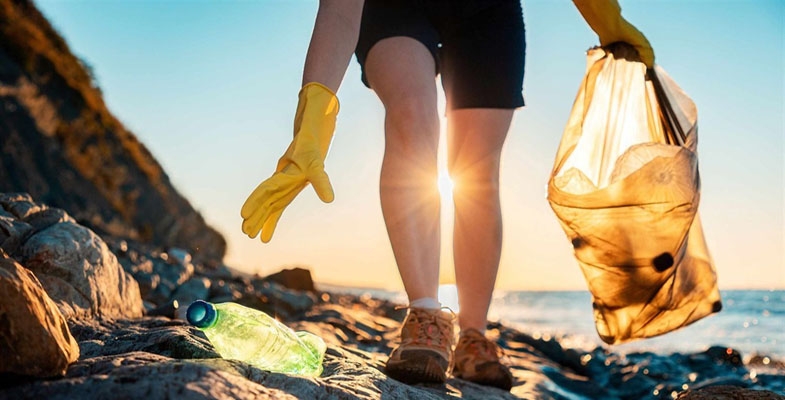The EPA has released a discussion paper on a plan to reduce the use of plastic and the quantity of waste generated. Comments may be made via a survey or you can email a submission to This email address is being protected from spambots. You need JavaScript enabled to view it. (closing date 6 November).
Due in part to past litter reduction initiatives such as the Return and Earn recycling scheme and the phase-out of lightweight plastic bags, there has already been a 49% reduction in litter density since 2018–19.
What about a major source of plastic – synthetic turf?
As an aside, there is a major source of plastic that is only going to get worse that is from synthetic turf playing fields and its general use for surfaces in parks and school grounds. This issue doesn’t come under the plan but could be referred to in submissions.
There is no effective method for recycling this product. Microplastics that end up in the environment from the break-up of the plastic grass blades and loose infill are a major concern that is being monitored by the AUSMAP project. There will be more about research on this in a future issue of STEP Matters.
Strong action is needed
There are still frightening statistics about the impact of litter and the volume of plastic ending up as waste in landfill. For example, in 2022–23, NSW alone generated 891,000 t of plastic waste. Only 14% of this was recycled.
About 79% of litter washed into our waterways is plastic. Plastic litter can have disastrous consequences and significant cost on the environment and communities.
For every piece of litter on land in NSW, nine times more can be found in our waterways.
As littered plastic items are exposed to water, sunlight and rain, they can break down over time into microplastics and leach potentially harmful chemicals into the environment. It can also entangle or be swallowed by marine animals.
Taking into account the direct costs of cleaning up litter, as well as the indirect costs associated with loss of amenity and environmental values, litter costs NSW more than $500 million.
Is the reduction plan good enough?
The Boomerang Alliance’s view on the proposals is that the plan includes some sound policy actions and a timeline for implementation, but many of these proposed measures may not deliver the needed reductions in plastic litter and waste. Here is a summary of their main points
Reusable cups at food venues (applied from 2027)
Currently, food venues may voluntarily accept reusable cups, but this needs to go further. All outlets should be required to offer reusable cups and containers or accept BYO, reducing reliance on disposables. In Europe, dine-in customers are never served with disposable food ware.
Recyclable single-use cups and containers (2027)
While recyclable or compostable containers are already common, the issue lies with inadequate collection systems. Simply labelling items for recycling won’t address the core issues.
Return and earn for single-use cups and containers (2030)
This proposal is both tokenistic and impractical. What we need is a robust reusable cup return system. Other countries have already implemented these models, which reduce plastic waste and greenhouse gas emissions. These systems could be adopted now.
Tethered caps on bottles (2030)
One never knows whether loose caps from milk and soft drink bottles can be recycled. Attached caps solve this question. This strong policy is already in place in Europe. So, why wait until 2030? Propose that it be introduced by 2026.
National approach to cigarette butt litter (2027)
Ideally eliminate cigarette filters altogether, as recommended by the World Health Organisation. A reusable holder could replace the need for single-use filters.
Elimination of harmful chemicals in packaging (2027)
While this is a positive step, if chemicals are harmful, they should not be used in the first place. Mandatory labelling of ‘green-listed’ chemicals is also essential.
Phase-out of microplastics (2025)
Support this, but there should be stronger measures, such as mandating filters on washing machines to capture microfibres, rather than relying on a proposed rating system by 2027.
Standards for reusable shopping bags (2025)
Require plastic shopping bags to be stored out of sight at the point of purchase and only provided on request, unless they are clearly designed for reuse or are part of an extended producer responsibility. Reusable bags must be durable, contain recycled content, and be recyclable at the end of their lifecycle.
Phase-out of various plastic items (2027)
Agree with the phase-out of plastic carrier bags, food tags, and other non-compostable items.
Ban on lighter-than-air balloons (2025)
This ban could be implemented immediately. There is no need to wait until 2025.
Phase out of expanded and foamed plastic trays and packaging (2025)
Support this phase-out and believe it should be done as soon as possible.
A final word on the Australian recycling label
This system needs to ensure that labelled items are genuinely recycled, reused, or composted. Without this, it’s simply greenwashing.

